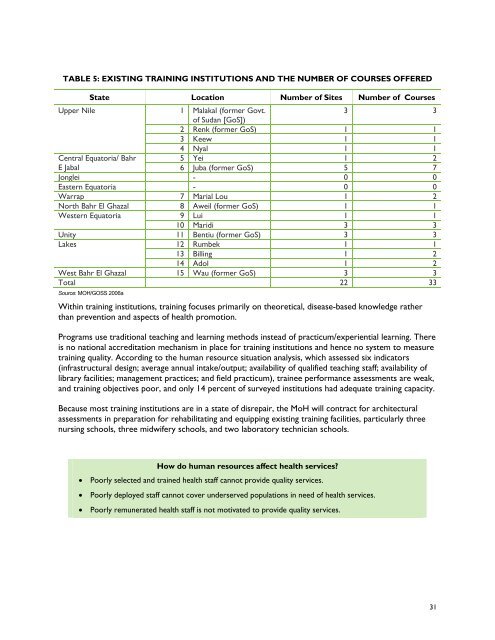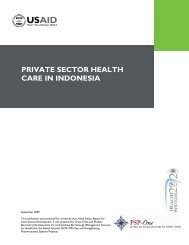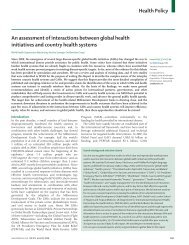southern sudan health system assessment - Health Systems 20/20
southern sudan health system assessment - Health Systems 20/20
southern sudan health system assessment - Health Systems 20/20
You also want an ePaper? Increase the reach of your titles
YUMPU automatically turns print PDFs into web optimized ePapers that Google loves.
TABLE 5: EXISTING TRAINING INSTITUTIONS AND THE NUMBER OF COURSES OFFERED<br />
State Location Number of Sites Number of Courses<br />
Upper Nile<br />
1 Malakal (former Govt.<br />
3 3<br />
of Sudan [GoS])<br />
2 Renk (former GoS) 1 1<br />
3 Keew 1 1<br />
4 Nyal 1 1<br />
Central Equatoria/ Bahr<br />
5 Yei 1 2<br />
E Jabal 6 Juba (former GoS) 5 7<br />
Jonglei - 0 0<br />
Eastern Equatoria - 0 0<br />
Warrap 7 Marial Lou 1 2<br />
North Bahr El Ghazal 8 Aweil (former GoS) 1 1<br />
Western Equatoria<br />
9 Lui 1 1<br />
10 Maridi 3 3<br />
Unity 11 Bentiu (former GoS) 3 3<br />
Lakes<br />
12 Rumbek 1 1<br />
13 Billing 1 2<br />
14 Adol 1 2<br />
West Bahr El Ghazal 15 Wau (former GoS) 3 3<br />
Total 22 33<br />
Source: MOH/GOSS <strong>20</strong>06a<br />
Within training institutions, training focuses primarily on theoretical, disease-based knowledge rather<br />
than prevention and aspects of <strong>health</strong> promotion.<br />
Programs use traditional teaching and learning methods instead of practicum/experiential learning. There<br />
is no national accreditation mechanism in place for training institutions and hence no <strong>system</strong> to measure<br />
training quality. According to the human resource situation analysis, which assessed six indicators<br />
(infrastructural design; average annual intake/output; availability of qualified teaching staff; availability of<br />
library facilities; management practices; and field practicum), trainee performance <strong>assessment</strong>s are weak,<br />
and training objectives poor, and only 14 percent of surveyed institutions had adequate training capacity.<br />
Because most training institutions are in a state of disrepair, the MoH will contract for architectural<br />
<strong>assessment</strong>s in preparation for rehabilitating and equipping existing training facilities, particularly three<br />
nursing schools, three midwifery schools, and two laboratory technician schools.<br />
How do human resources affect <strong>health</strong> services<br />
• Poorly selected and trained <strong>health</strong> staff cannot provide quality services.<br />
• Poorly deployed staff cannot cover underserved populations in need of <strong>health</strong> services.<br />
• Poorly remunerated <strong>health</strong> staff is not motivated to provide quality services.<br />
31
















